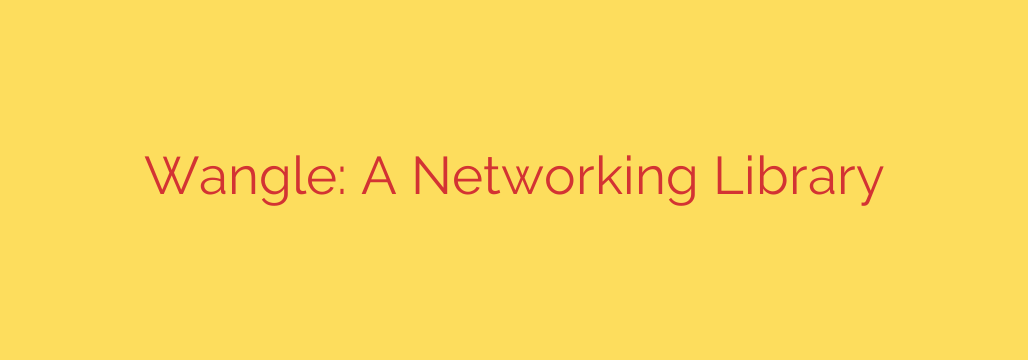
Wangle: The High-Performance C++ Networking Library You Need to Know
In the world of modern software development, the demand for high-performance, scalable, and resilient network services has never been greater. For C++ developers, building these services from the ground up can be a complex and error-prone task. This is where Wangle, a powerful open-source networking library, comes into play.
Developed and battle-tested at Meta, Wangle provides a robust framework for creating asynchronous, event-driven network applications in C++. If you’re familiar with the highly popular Java networking library Netty, you’ll feel right at home with Wangle, as it draws heavy inspiration from Netty’s design principles and architecture.
Let’s dive into what makes Wangle an essential tool for any C++ developer working on network-intensive projects.
What Exactly is Wangle?
At its core, Wangle is a library that simplifies the complexities of network programming. It enables developers to build server and client applications that can handle thousands of concurrent connections efficiently without getting bogged down by traditional blocking I/O models.
Instead of managing threads and sockets manually, Wangle provides a higher-level abstraction built around an event-driven architecture. This means your application reacts to network events (like a new connection, incoming data, or a closed socket) as they happen, allowing a small number of threads to manage a massive amount of traffic.
The Core of Wangle: Pipelines and Handlers
The central concept in Wangle is the Pipeline. You can think of a Pipeline as an assembly line for network data. When data comes in or goes out, it passes through a series of “handlers” that you define. Each handler is responsible for a specific, isolated piece of logic.
This modular approach has several key advantages:
- Separation of Concerns: Your business logic is neatly separated from the low-level networking code. One handler might be responsible for TLS encryption/decryption, another for decoding a specific protocol (like HTTP), and a third for executing the actual business logic.
- Reusability: Handlers are reusable components. A TLS handler you write for one application can be easily dropped into another.
- Testability: Each handler can be tested in isolation, making your code more reliable and easier to debug.
A typical Wangle pipeline for a server might look like this:
- TLS Handler: Manages secure communication by encrypting and decrypting data.
- Codec Handler: Encodes and decodes data from raw bytes into a specific message format (e.g., JSON or a custom binary protocol).
- Application Logic Handler: Processes the decoded message and generates a response.
This clean, ordered flow is what makes Wangle so powerful and maintainable.
Key Features and Benefits of Using Wangle
Opting for Wangle brings a suite of powerful features designed for modern, high-load environments.
- High Performance: Built on top of
folly, Meta’s open-source C++ library, Wangle is optimized for performance and efficiency, capable of handling the massive scale required by services like Facebook and Instagram. - Asynchronous from the Ground Up: Wangle leverages Futures and Promises (specifically
folly::Future) to manage asynchronous operations. This prevents your application from blocking on slow network or disk I/O, ensuring it remains responsive under heavy load. - Protocol Agnostic: While perfect for building HTTP servers, Wangle is not tied to any specific protocol. You can implement handlers for any custom TCP or UDP-based protocol, making it incredibly versatile.
- Built-in Security: Wangle provides first-class support for TLS (Transport Layer Security), allowing you to secure your client and server communications with ease. Implementing encryption is not an afterthought but an integrated part of the framework.
Actionable Security Tips for Your Wangle Application
While Wangle provides a secure foundation, developers are still responsible for building a secure application. Here are some critical security practices to follow:
- Always Enable TLS: For any production service, encrypting data in transit is non-negotiable. Use Wangle’s
SSLContextConfigto correctly configure your TLS certificates and enable secure communication from the start. - Implement Strict Input Validation: Your handlers are the entry point for all external data. Never trust incoming data. Meticulously validate all inputs for correct format, length, and type to prevent common vulnerabilities like buffer overflows and injection attacks.
- Manage Resources Carefully: In an event-driven model, it’s crucial to manage connection lifecycles and resources properly. Implement timeouts for idle connections and set limits on buffer sizes to protect your service from resource exhaustion and Denial-of-Service (DoS) attacks.
- Keep Dependencies Updated: Wangle depends on other libraries, like Folly and OpenSSL. Regularly update these dependencies to ensure you have the latest security patches and performance improvements.
Conclusion: A Modern Toolkit for C++ Networking
Wangle represents a significant step forward for C++ network programming. By providing a well-structured, asynchronous, and highly performant framework, it empowers developers to build scalable and robust network services without getting lost in the weeds of low-level socket management.
If you are a C++ developer tasked with building a high-throughput server, a responsive client, or any application where network performance is critical, Wangle is a library that deserves your full attention. Its modular pipeline architecture not only streamlines development but also promotes building more secure, testable, and maintainable code.
Source: https://www.linuxlinks.com/wangle-networking-library/








